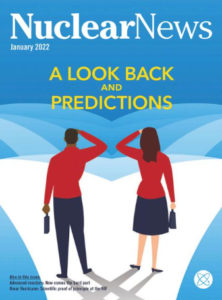 The January 2022 issue of Nuclear News, an industry publication produced by the American Nuclear Society, included 30 predictions from nuclear industry professionals, four of which came from faculty in the department.
The January 2022 issue of Nuclear News, an industry publication produced by the American Nuclear Society, included 30 predictions from nuclear industry professionals, four of which came from faculty in the department.
Predictions for the nuclear industry included comments by Associate Professor and Southern Company Fellow Jamie Coble, Associate Professor Nick Brown, John D. Tickle Professor Lawrence Heilbronn, and Postelle Professor, Chancellor’s Professor, and Department Head Wes Hines. Their predictions are reprinted below with permission from the publisher.
Associate Professor and Southern Company Fellow Jamie Coble
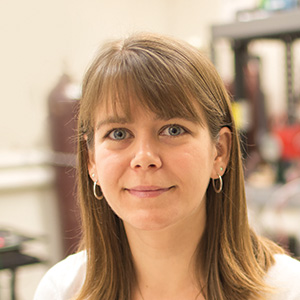 I hope that there is a continued focus on artificial intelligence/machine learning-enhanced situational awareness for operators and engineers, particularly including presenting cybersecurity-relevant information to operations personnel. I’d like to see a deeper push for transparent and explainable AI to support both operator acceptance and regulatory acceptance (and related regulatory relief). Basically, I hope there will be some big advances in using data analytics, machine learning, and digital twins across the fleet to improve situational awareness and decision-making (which in turn I hope leads to greater economic competitiveness of nuclear by looking at new ways to operate in the energy market.)
I hope that there is a continued focus on artificial intelligence/machine learning-enhanced situational awareness for operators and engineers, particularly including presenting cybersecurity-relevant information to operations personnel. I’d like to see a deeper push for transparent and explainable AI to support both operator acceptance and regulatory acceptance (and related regulatory relief). Basically, I hope there will be some big advances in using data analytics, machine learning, and digital twins across the fleet to improve situational awareness and decision-making (which in turn I hope leads to greater economic competitiveness of nuclear by looking at new ways to operate in the energy market.)
John D. Tickle Professor Lawrence H. Heilbronn; Chair, Radiation Protection and Shielding Division
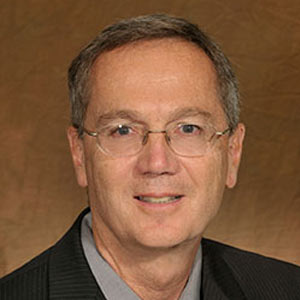 ANS Radiation Protection and Shielding Division professionals look forward to continuing their efforts in addressing the ANS Grand Challenge on low-dose radiation—to establish the scientific basis for low-dose radiation regulation. Those efforts include advocating for federal support for research on the biological effects of low-dose ionizing radiation, as well as developing strategies for a long-term program in that area. The RPSD membership will continue their assistance in the development of the ANS statement on the linear-no-threshhold model, a key component of the ANS response to the low-dose radiation Grand Challenge. Modeling of radiation transport and radiation effects will remain a major focus of research for RPSD membership.
ANS Radiation Protection and Shielding Division professionals look forward to continuing their efforts in addressing the ANS Grand Challenge on low-dose radiation—to establish the scientific basis for low-dose radiation regulation. Those efforts include advocating for federal support for research on the biological effects of low-dose ionizing radiation, as well as developing strategies for a long-term program in that area. The RPSD membership will continue their assistance in the development of the ANS statement on the linear-no-threshhold model, a key component of the ANS response to the low-dose radiation Grand Challenge. Modeling of radiation transport and radiation effects will remain a major focus of research for RPSD membership.
Additionally, as the nation prepares for its return to the moon this decade and then on to Mars later this century, RPSD will play a part in mitigating the radiation risk in those missions and will assist other ANS divisions involved with nuclear technologies that will be a part of humankind’s exploration of space. The highlight of 2022 will be the ICRS 14/RPSD 2022 conference to be held in Seattle, Washington, September 25-29, our major international conference that returns after a two-year delay due to COVID restrictions. We hope to see you there.
Associate Professor Nicholas Brown; Chair, Nuclear Installations Safety Division
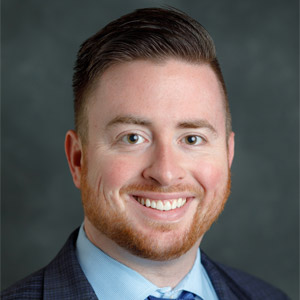 Nuclear energy is achieving wide recognition as a crucial part of the solution to global climate change. However, competition with other energy sources and premature plant closures are challenging circumstances the industry continues to face.
Nuclear energy is achieving wide recognition as a crucial part of the solution to global climate change. However, competition with other energy sources and premature plant closures are challenging circumstances the industry continues to face.
In 2022, we will continue to see the unprecedented opportunity in nuclear energy starting with the phenomenal job Prof. Katy Huff is doing leading the Department of Energy Office of Nuclear Energy. I have been very excited to see the Advance Reactor Demonstration Program kickoff and the expansion of the Nuclear Energy University Program with additional budget and scope. I believe Prof. Huff will continue her already excellent track record of advancing reactor deployment and improving our talent pipeline. Activities to modernize our regulatory approach will continue to make headway in 2022. In March 2021, the ANS Advanced Reactors Working Group sent a letter to the Nuclear Regulatory Commission advocating for incorporating into the Code of Federal Regulations Part 53 rulemaking decades of experience with risk-informed and performance-based regulation and philosophy. Efforts like this will continue to grow and make a positive impact in the next year and beyond.
In the Nuclear Safety Installations Division, we are proud to be ANS’s home of risk assessment. NISD and its predecessor, the Nuclear Reactor Safety Division, has historically played a role in hosting topical meetings in advanced reactors and traditional nuclear safety assessment. We are excited to see the growth in interest in risk assessment and its incorporation into the licensing process. The time is right to resurrect the embedded topical meetings on reactor safety. Therefore, we are excited to begin planning for the future Advanced Reactor Safety Conference, which will be held in conjunction with the 2024 ANS Annual Meeting under the leadership of Matt Denman, Kevin O’Kula, and others in the division.
Department Head Wes Hines
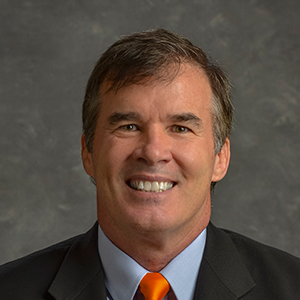 It seems clear that 2022 will continue two trends in nuclear: the need for decommissioning skills and ongoing safety training, and educating the next generation. At the University of Tennessee, Knoxville, we have made several recent changes to our curriculum to better prepare our students to meet the future’s nuclear challenges. First, we have implemented two new undergraduate minors: one in nuclear safety and one in nuclear decommissioning and environmental management. Safety is always our number one priority, and through a partnership with Bechtel, we have a new course in nuclear licensing and have updated several other courses to meet today’s needs. We also integrated these courses into a graduate concentration in nuclear safety. As plants are shutting down, we have partnered with UCOR to develop a minor to better prepare our students for the challenges of efficiently decommissioning plants and returning the land for reuse.
It seems clear that 2022 will continue two trends in nuclear: the need for decommissioning skills and ongoing safety training, and educating the next generation. At the University of Tennessee, Knoxville, we have made several recent changes to our curriculum to better prepare our students to meet the future’s nuclear challenges. First, we have implemented two new undergraduate minors: one in nuclear safety and one in nuclear decommissioning and environmental management. Safety is always our number one priority, and through a partnership with Bechtel, we have a new course in nuclear licensing and have updated several other courses to meet today’s needs. We also integrated these courses into a graduate concentration in nuclear safety. As plants are shutting down, we have partnered with UCOR to develop a minor to better prepare our students for the challenges of efficiently decommissioning plants and returning the land for reuse.
We have also assessed our undergraduate curriculum and developed several new core classes that better meet nuclear workforce needs. We developed a nuclear materials course to take the place of a general material science course to focus on current material issues related to nuclear power. We also developed our nuclear laboratory course to introduce state-of-the-art nuclear codes that are used to simulate the experiments conducted in the laboratory. The comparison of code results with experimental results give our students the expertise to utilize computer simulations and understand the assumptions and inherent errors.